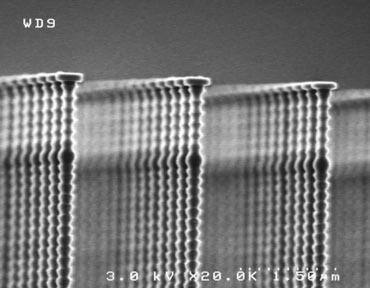Home > Press > With a jolt, 'nanonails' go from repellant to wettable
 |
| Silicon "nanonails" created by Tom Krupenkin and J. Ashley Taylor of University of Wisconsin-Madison's Department of Mechanical Engineering, form the basis of a novel surface that repels virtually all liquids, including water, solvents, detergents and oils. When electrical current is applied, the liquids slip past the nail heads and between the shanks of the nails and wet the entire surface. The surface may have applications in biomedical devices such as "labs-on-a-chip" and in extending the life of batteries. Photo by: courtesy Tom Krupenkin |
Abstract:
Sculpting a surface composed of tightly packed nanostructures that resemble tiny nails, University of Wisconsin-Madison engineers and their colleagues from Bell Laboratories have created a material that can repel almost any liquid.
With a jolt, 'nanonails' go from repellant to wettable
Madison, WI | Posted on January 30th, 2008 Add a jolt of electricity, and the liquid on the surface slips past the heads of the nanonails and spreads out between their shanks, wetting the surface completely.
The new material, which was reported this month in Langmuir, a journal of the American Chemical Society, could find use in biomedical applications such as "lab-on-a- chip" technology, the manufacture of self-cleaning surfaces, and could help extend the working life of batteries as a way to turn them off when not in use.
UW-Madison mechanical engineers Tom Krupenkin and J. Ashley Taylor and their team etched a silicon wafer to create a forest of conductive silicon shanks and non-conducting silicon oxide heads. Intriguingly, the ability of the surface of the structure to repel water, oil, and solvents rests on the nanonail geometry.
"It turns out that what's important is not the chemistry of the surface, but the topography of the surface," Krupenkin explains, noting that the overhang of the nail head is what gives his novel surface its dual personality.
A surface of posts, he notes, creates a platform so rough at the nanoscale that "liquid only touches the surface at the extreme ends of the posts. It's almost like sitting on a layer of air."
####
For more information, please click here
Contacts:
Tom Krupenkin
(608) 890-1948
Copyright © University of Wisconsin-Madison
If you have a comment, please Contact us.Issuers of news releases, not 7th Wave, Inc. or Nanotechnology Now, are solely responsible for the accuracy of the content.
| Related News Press |
News and information
![]() Simulating magnetization in a Heisenberg quantum spin chain April 5th, 2024
Simulating magnetization in a Heisenberg quantum spin chain April 5th, 2024
![]() NRL charters Navy’s quantum inertial navigation path to reduce drift April 5th, 2024
NRL charters Navy’s quantum inertial navigation path to reduce drift April 5th, 2024
![]() Discovery points path to flash-like memory for storing qubits: Rice find could hasten development of nonvolatile quantum memory April 5th, 2024
Discovery points path to flash-like memory for storing qubits: Rice find could hasten development of nonvolatile quantum memory April 5th, 2024
Discoveries
![]() Chemical reactions can scramble quantum information as well as black holes April 5th, 2024
Chemical reactions can scramble quantum information as well as black holes April 5th, 2024
![]() New micromaterial releases nanoparticles that selectively destroy cancer cells April 5th, 2024
New micromaterial releases nanoparticles that selectively destroy cancer cells April 5th, 2024
![]() Utilizing palladium for addressing contact issues of buried oxide thin film transistors April 5th, 2024
Utilizing palladium for addressing contact issues of buried oxide thin film transistors April 5th, 2024
Announcements
![]() NRL charters Navy’s quantum inertial navigation path to reduce drift April 5th, 2024
NRL charters Navy’s quantum inertial navigation path to reduce drift April 5th, 2024
![]() Discovery points path to flash-like memory for storing qubits: Rice find could hasten development of nonvolatile quantum memory April 5th, 2024
Discovery points path to flash-like memory for storing qubits: Rice find could hasten development of nonvolatile quantum memory April 5th, 2024
Battery Technology/Capacitors/Generators/Piezoelectrics/Thermoelectrics/Energy storage
![]() What heat can tell us about battery chemistry: using the Peltier effect to study lithium-ion cells March 8th, 2024
What heat can tell us about battery chemistry: using the Peltier effect to study lithium-ion cells March 8th, 2024
![]() A battery’s hopping ions remember where they’ve been: Seen in atomic detail, the seemingly smooth flow of ions through a battery’s electrolyte is surprisingly complicated February 16th, 2024
A battery’s hopping ions remember where they’ve been: Seen in atomic detail, the seemingly smooth flow of ions through a battery’s electrolyte is surprisingly complicated February 16th, 2024
|
|
||
|
|
||
| The latest news from around the world, FREE | ||
|
|
||
|
|
||
| Premium Products | ||
|
|
||
|
Only the news you want to read!
Learn More |
||
|
|
||
|
Full-service, expert consulting
Learn More |
||
|
|
||








